As I sit here looking at my Xbox Live friend’s list, my mind wanders back to a time when playing video games over long distance communications seemed like something that couldn’t come soon enough. Few people had modems back then, and in the days before online gaming became the norm, playing against someone over the phone could be an expensive endeavor. Gameline had tried and failed, and Nintendo was very cautious about its own Famicom modem, which never left its native Japan. Imagine then, what it was like to see those initial Genesis posters that had the TeleGenesis modem so proudly displayed, prompting prospective buyers into believing that they would soon be enjoying the likes of titles like Golden Axe and Shinobi with friends across the country.
Nintendo Makes the First Move
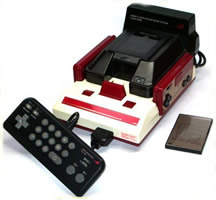 Let’s go back to what I said about Nintendo for a second. We all know that the NES was dominant in the U.S. during the late ’80s, and its hold on the Japanese market was even stronger. In 1989 the company decided to take the next step and bring the NES to those outside of the video game world. Nintendo head Hiroshi Yamauchi had long intended for the console to gain mass appeal, beyond the millions of children already enjoying the exploits of Mario and Link. He was eager to see the NES be taken seriously as a business tool, and envisioned parents, as well as their children, using it as part of their daily lives. Banking, stock management, weather and news – all of it was to offered through a telephone connection, giving adults a concrete reason for picking up a shiny new NES beyond that of the pleas of their children (though kids weren’t left out, as the Super Mario Club provided reviews and previews of games). Known as the Famicom Tsushin (communication) system, users could access a network run by Nintendo and NTT via a 2400 bps modem. Head-to-head gaming was not a selling point, as Nintendo was aiming this squarely at an adult audience.
Let’s go back to what I said about Nintendo for a second. We all know that the NES was dominant in the U.S. during the late ’80s, and its hold on the Japanese market was even stronger. In 1989 the company decided to take the next step and bring the NES to those outside of the video game world. Nintendo head Hiroshi Yamauchi had long intended for the console to gain mass appeal, beyond the millions of children already enjoying the exploits of Mario and Link. He was eager to see the NES be taken seriously as a business tool, and envisioned parents, as well as their children, using it as part of their daily lives. Banking, stock management, weather and news – all of it was to offered through a telephone connection, giving adults a concrete reason for picking up a shiny new NES beyond that of the pleas of their children (though kids weren’t left out, as the Super Mario Club provided reviews and previews of games). Known as the Famicom Tsushin (communication) system, users could access a network run by Nintendo and NTT via a 2400 bps modem. Head-to-head gaming was not a selling point, as Nintendo was aiming this squarely at an adult audience.
But something happened. Almost immediately, Nintendo had to back off its U.S. ambitions of bringing the NES online. Control Data Corp., which handled the lotteries in many U.S. states, was ready to go ahead with a limited test of ten thousand homes, each paying $10 a month for a special cartridge and access to the lottery network. Unfortunately, despite major anticipation and estimates that the new service would increase lottery volume by ten to fifteen percent, criticism from Minnesota’s attorney general about how easy it was for children to access it led to its demise. Nintendo’s lottery-at-home plan in Minnesota died a quick death after both it and the state government decided that NES-savvy youngsters might end up betting alongside adults.
The Nintendo Network’s debut in America suffered a similar stillbirth. In 1989, the company announced that it planned to have ten million homes connected by 1991. Initially designed as a business network that was to be carried by AT&T, disappointing market research showed that only about seven percent of NES-able homes had accounts with brokerages, most already using a network of their own. Nintendo had to shift focus, deciding instead to offer a service that would offer chat and email, as well as game reviews and previews. Moreover, NES owners would be able to download games onto a forthcoming floppy disc drive. None of this came to fruition, however, as the emergence of the Genesis as a viable threat and the upcoming release of the SNES moved the plan to the back burner, where it was quickly forgotten.
Nintendo’s dream of bringing online gaming to the U.S. was over.
Sega Steps Up
Rewind to 1988. Sega is busily preparing its new 16-bit Mega Drive console for launch in the U.S. Already released in Japan as the Mega Drive, it faces an uphill battle against the raging NES, and Sega knows it needs to cover all the bases, including having a network of its own. A modem is announced that will not only provide gaming news and reviews, but will allow gamers to play against each other via their telephone lines, something Nintendo was unable to include in its online set up. Roughly nine inches long and plugging into the nine-pin expansion port at the rear of the console, the sleek, black Mega Modem (as it was called in Japan) was supposed to add a whole new level of gaming to the fledgling Mega Drive. A cord ran from it and into to a dual-line connector, which plugged into your phone jack. It was released in Japan on October 21, 1990 and retailed for ¥12,800 (roughly $100 at the time), with the Meganet online service costing $35 for six months. The modem came bundled with the Sega Network Cartridge and access to the Sega Game Library (SGL), which allowed owners to download and play games through a simple menu system. About a half dozen titles were available at launch, with many more promised in the immediate future. Downloads were rumored to take between five and eight minutes.
Promptly featured in the first batch of Sega advertising, the product was renamed the “TeleGenesis Modem,” alongside the newly christened Genesis, for domestic release. Magazines like Electronic Gaming Monthly and Mega Play ran news blurbs it, but not much more, as information from Sega was slow in coming.
Sega Thinks It Has the “Anser”
Though gaming was to be a major part of the Seganet service, Sega was thinking beyond its traditional audience. Much like Nintendo, it sought to expand the appeal of its hardware and offer adults a reason to purchase a Mega Drive. Dubbed the “Mega Anser” (their misspelling, not mine), this online service sported many of the same features as the Nintendo Network. MD users could insert the cartridge to their connected console and leave it to download news and weather, as well as do some simple bank tasks like check balances, make transfers, provide loan information, and even print out data on the optional printer. The whole set up was quite complex for the time, and while the majority of gamers had no use for such services, Sega obviously felt that someone in Japan had a need for such a device.
Yes, all this online goodness was made possible through the Mega Modem for only ¥34,000 (around $267 USD, which included the Mega Modem, ten-key pad, and Mega Anser cartridge) or ¥72,800 ($573 USD) for a set that also included a printer). Considering that the Mega Drive was retailing in Japan for just under $200 American dollars, all this added this added hardware was entirely too expensive for the average consumer, and weak sales further closed the window of bringing full online functionality to the Mega Drive. Sega was struggling to establish a new 16-bit brand, and few people were willing to risk so much cash for a yet-unproven game console.
On the positive side, it looked like Sega had at least managed to be successful in the one aspect where its main competitor had failed: bringing online gaming to the console masses; however, though a rudimentary service had been launched, it soon became apparent just how difficult it would be to make such an ambition a viable reality.
Faulty Signal
Obviously trying to trump Nintendo and ahead of potential competitors TelePlay Modem (1992) and the Xband (1994) by years, Sega’s bold decision for long distance gaming (LDG) didn’t just run into some trouble; it smashed head-first into a solid brick wall. As we all know now, mounting an online network is a massive undertaking, with the most successful example, Microsoft, taking a full five years to deliver on the full promise of Xbox Live. Back in the 1980s, this was unknown territory, and most thought that the prospect of LDG was years off, at best. Still, the potential and interest were there, and the gaming press was quick to note the progress that was (supposedly) being made. For instance, take this quote from Electronic Gaming Monthly #8 (March, 1990) regarding the still MIA modem:
Even though the TeleGenesis modem has been announced, it has yet to appear and the real usefulness of a device that is used only to play games with friends over the phone lines remains questionable (both have to have the modem, the phone lines must be clear, the phone bills will be a problem if it’s a long-distance call, etc.). But a Sega Game Network, which is accessed either directly or through an existing service like CompuServe or Genie, would be an extremely exciting development for the Sega modem. A game network that allows you to pull Sega 16-bit games from a menu off of the phone lines and into your games will soon be available in Japan, so why not in the U.S.? Rumors indicate that it’s close to reality on these shores as well so the modem may become a viable utility in the future.
While at first glance it may appear that EGM was way off base in its predictions, we should remember that the rumor of “a game network that allows you to pull Sega 16-bit games from a menu” was eventually realized as the Sega Channel. Even so, the blurb was somewhat hesitant to come out and say “it’s coming” when referring to the actual Genesis modem. EGM was quite clear and correct in pointing out the logistical problems of early online gaming, and these troubles would once again rear their heads when the Xband was launched in November of 1994. Even if enough units were sold to ensure developer support and a decent catalogue of games, long distance phone bills were sure to still be a problem. Much like the Mega Anser in Japan, the high price tag of the console, modem, and monthly phone charges would be enough to ward off even the most eager gamer. Despite the TeleGenesis Modem’s attraction, the high price of such an investment was just beyond what gamers of the day were capable and willing to pay.
Compounding the cost issue was the technical one. Though Sega was able to up the baud rate from the prototype unit’s feeble 1200, there was still rumored to be three to four second lag between commands. This would have a potentially crippling effect on games that weren’t quick and easy plays, such as baseball and RPGs. With the Mega Drive struggling in Japan, Nintendo’s announcement of its impending 16-bit console, and a mixed reception from the gaming press, things didn’t bode well for the U.S. TeleGenesis modem. Sega had little choice but to cut it loose.
Interestingly enough, Sega never actually came forward and officially cancelled the modem. No press release, no public announcement — the whole thing just seemed to suddenly fade away. Genesis owners remained hopeful, though Sega’s mixed signals didn’t help their situation. For instance, the Oct./Nov. issue of Sega Visions magazine still towed the corporate line, as was seen in its “Game Doctor” section, where a submitted question asking about the future of the device in America was answered thusly:
The modem has already been released in Japan, but it is used there largely for home banking. Sega of America wants to make sure that there is quality modem-based entertainment software in development before it considers releasing the modem in this country.
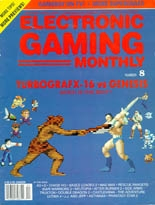 This makes little sense when you think about it. While virtually all Master System and early Genesis software were done in Japan, Sega had made a point to beef up its American development branch. Then-SoA president Michael Katz and Head of Product Development Ken Balthaser have both admitted as much. So why would there now be so much dependence on Japan? Was Sega of America unable or unwilling to develop modem-ready games itself? Who then, did it expect would dedicate resources to something that might not even come out? Companies were most likely waiting for confirmation of the modem’s release before they began to commit themselves, and as time has attested, few were waiting to go ahead with development in light of Sega’s “wait and see” attitude. This was a lesson Sega would not learn, and the same mistake would be committed with the 32X. History would repeat itself in the harshest of manners only five years later. Sega’s expectations of third party support for something it showed little enthusiasm for were entirely unrealistic and ultimately meant that no games would be in the pipeline.
This makes little sense when you think about it. While virtually all Master System and early Genesis software were done in Japan, Sega had made a point to beef up its American development branch. Then-SoA president Michael Katz and Head of Product Development Ken Balthaser have both admitted as much. So why would there now be so much dependence on Japan? Was Sega of America unable or unwilling to develop modem-ready games itself? Who then, did it expect would dedicate resources to something that might not even come out? Companies were most likely waiting for confirmation of the modem’s release before they began to commit themselves, and as time has attested, few were waiting to go ahead with development in light of Sega’s “wait and see” attitude. This was a lesson Sega would not learn, and the same mistake would be committed with the 32X. History would repeat itself in the harshest of manners only five years later. Sega’s expectations of third party support for something it showed little enthusiasm for were entirely unrealistic and ultimately meant that no games would be in the pipeline.
The Line Goes Dead
Sega quietly cancelled its plans for a U.S. release of the TeleGenesis modem in 1990 but went ahead with a limited Japanese launch that same year. Few titles were available, and along with the Mega Drive’s lackluster sales, caused the network to be taken offline a year later. By mid 1992, the Mega Modem could be had for a song in bargain bins. They’re still available on sites such as eBay, but much like the Xband modem and Sega Channel cartridge, have no use save as a conversation piece.
The TeleGenesis never amounted to much in America outside of a few appearances in early Genesis advertising. Two famous posters feature it (it’s the Japanese version of the modem, and it is unclear if there was to be any physical difference between the two), and it was featured in a few magazines. No official explanation was given for its demise, and it soon disappeared entirely from Sega’s ads.
So What’s Out There?
Around sixteen games made use of the Mega Modem (eight of them belonging to the Phantasy Star II text adventure series), but the official number varies depending on who you ask. Those titles confirmed to have been released are listed below, and we will add to this list as more games are confirmed. A few other titles, such as Fatal Labyrinth and Flicky, were rumored to have originated as SGL titles, only to have their online components eliminated when the network was scrapped and they were released in the U.S. in cartridge form. Of all the games released, only the two TEL-TEL titles actually featured modem-to modem play. The others were all downloadable and were played offline.
Advanced Daisenryaku
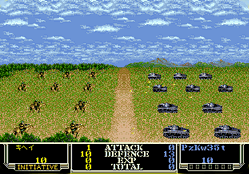 Sim Soft’s famous WWII strategy game, which has been around seemingly forever, was actually released with online play. Unlike many of the other titles here, Advanced Daisenryaku was actually quite well suited for the lag that such early phone play suffered. Strategy titles are not known for their breakneck pace, and it might not have been enough to really affect gameplay. The only negative here would be the massive phone bills from playing the campaign online. Unfortunately, the game never playable online and was left in Japan, and the series didn’t make its way to the U.S. on a Sega console until Working Designs brought over the incredible Iron Storm for the Saturn.
Sim Soft’s famous WWII strategy game, which has been around seemingly forever, was actually released with online play. Unlike many of the other titles here, Advanced Daisenryaku was actually quite well suited for the lag that such early phone play suffered. Strategy titles are not known for their breakneck pace, and it might not have been enough to really affect gameplay. The only negative here would be the massive phone bills from playing the campaign online. Unfortunately, the game never playable online and was left in Japan, and the series didn’t make its way to the U.S. on a Sega console until Working Designs brought over the incredible Iron Storm for the Saturn.
Cyberball
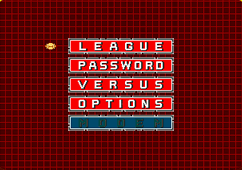 Essentially the same game as its U.S. counterpart, there is one simple distinction that most American gamers never noticed. Place the cartridge in a Japanese console, or set the region detection in Gens to Japan, and a modem option appears in the game menu. Considering that Cyberball is the only game on this list to make it across the Pacific, it is interesting to note that Genesis owners got a modem-ready game, without ever laying their hands on the modem itself. How it actually would have played online is anyone’s guess, since its online mode was not enabled, but those who are familiar with Cyberball know that it wasn’t anything like regular football in speed, so the slow modem might not have been a hindrance here. Too bad we’ll never know.
Essentially the same game as its U.S. counterpart, there is one simple distinction that most American gamers never noticed. Place the cartridge in a Japanese console, or set the region detection in Gens to Japan, and a modem option appears in the game menu. Considering that Cyberball is the only game on this list to make it across the Pacific, it is interesting to note that Genesis owners got a modem-ready game, without ever laying their hands on the modem itself. How it actually would have played online is anyone’s guess, since its online mode was not enabled, but those who are familiar with Cyberball know that it wasn’t anything like regular football in speed, so the slow modem might not have been a hindrance here. Too bad we’ll never know.
Phantasy Star II Text Adventures
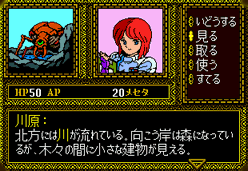 Featuring a cadre of eight cast members from the franchise’s Genesis debut, these text-based games were released as downloads, and they eventually resurfaced as part of a two-disc series that appeared on the Mega CD (again, only in Japan). Perhaps the best suited for the slow modem and requiring no second player to work, these were definite treats for fans of the series. Very little is known about the plot of each installment, where they fit in to the game’s plotline, or if they even tell of post-Phantasy Star II adventures. Still, the idea was novel, and it gave those who beat the main game a way to savor the sweetness a little longer. A good thing to note is that almost all of them have been translated, so it’s now possible to play the series and see what happened.
Featuring a cadre of eight cast members from the franchise’s Genesis debut, these text-based games were released as downloads, and they eventually resurfaced as part of a two-disc series that appeared on the Mega CD (again, only in Japan). Perhaps the best suited for the slow modem and requiring no second player to work, these were definite treats for fans of the series. Very little is known about the plot of each installment, where they fit in to the game’s plotline, or if they even tell of post-Phantasy Star II adventures. Still, the idea was novel, and it gave those who beat the main game a way to savor the sweetness a little longer. A good thing to note is that almost all of them have been translated, so it’s now possible to play the series and see what happened.
Putter Golf
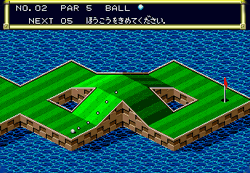 Like mini golf? Then this is the game for you. It plays much in the same fashion as many billiards titles, with you manipulating the ball’s path through a cursor and then deciding how much force goes into each hit. As this is putting only, many of the courses are very complex and offer lots of challenge. As golf games go, it’s not all that bad and is a decent way to spend some time. I don’t see this one offering too much trouble as a download, and the lack of a two-player game is questionable. Games like this work quite well online, and Putter Golf would probably have run pretty smoothly, since lag would have essentially been a non-factor here. Question: Is this title related to the Game Gear Putt & Putter Golf?
Like mini golf? Then this is the game for you. It plays much in the same fashion as many billiards titles, with you manipulating the ball’s path through a cursor and then deciding how much force goes into each hit. As this is putting only, many of the courses are very complex and offer lots of challenge. As golf games go, it’s not all that bad and is a decent way to spend some time. I don’t see this one offering too much trouble as a download, and the lack of a two-player game is questionable. Games like this work quite well online, and Putter Golf would probably have run pretty smoothly, since lag would have essentially been a non-factor here. Question: Is this title related to the Game Gear Putt & Putter Golf?
Pyramid Magic
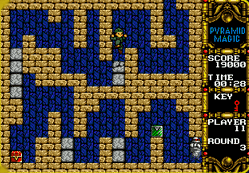 Fans of Solomon’s Key would like Pyramid Magic. It sports the same “find the key and leave” gameplay that made Tecmo’s classic so addictive. It’s also as bare bones as can be. The plot is a single screen long (and that presumably includes gameplay instructions as well), but once you begin playing, no help is needed. Use rocks to get over tall obstacles and to hunch down low enough to pass through small spaces, and jump on the two chests to gather the colored keys needed to access the final exit talisman. There’s a ton of levels, and though your bonus is time-based, there’s no limit. One word of caution though: there’s only a single way out of each room, and you have to be very careful about which rocks you decide to break. Simple yet addictive fun.
Fans of Solomon’s Key would like Pyramid Magic. It sports the same “find the key and leave” gameplay that made Tecmo’s classic so addictive. It’s also as bare bones as can be. The plot is a single screen long (and that presumably includes gameplay instructions as well), but once you begin playing, no help is needed. Use rocks to get over tall obstacles and to hunch down low enough to pass through small spaces, and jump on the two chests to gather the colored keys needed to access the final exit talisman. There’s a ton of levels, and though your bonus is time-based, there’s no limit. One word of caution though: there’s only a single way out of each room, and you have to be very careful about which rocks you decide to break. Simple yet addictive fun.
Shinkinjo
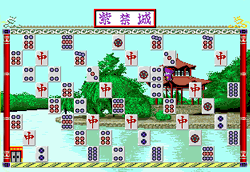 Forgive my ignorance regarding this particular title, as all I could decipher about the gameplay was that you play a tiny Japanese figure that has to match tiles (which disappear on contact) in order to open a path to the exit. Certain tiles bearing a red Japanese symbol will convert your tile if they touch, stopping it in its tracks. Think of a Japanese version of Shove It! The Warehouse Game, and you’ll have the right idea. The trick seems to be to somehow connect only the tiles you need to get to the exit. It seems strategic enough, but I don’t think it really stood well against the other downloadable titles listed here. Pushing tiles is only so much fun.
Forgive my ignorance regarding this particular title, as all I could decipher about the gameplay was that you play a tiny Japanese figure that has to match tiles (which disappear on contact) in order to open a path to the exit. Certain tiles bearing a red Japanese symbol will convert your tile if they touch, stopping it in its tracks. Think of a Japanese version of Shove It! The Warehouse Game, and you’ll have the right idea. The trick seems to be to somehow connect only the tiles you need to get to the exit. It seems strategic enough, but I don’t think it really stood well against the other downloadable titles listed here. Pushing tiles is only so much fun.
Sonic Eraser
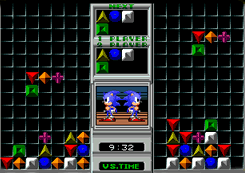 It makes perfect sense to include a puzzle game with the Meganet service, and what better way to get it off the ground than to include your official mascot? Sonic was most likely tacked on at the last minute, as the game itself doesn’t really have anything to do with him. All you really do is match up clusters of four colored geometric shapes to make them disappear, much in the same vein as Tetris. With seven different shapes in all, there’s potential for big combo points.
It makes perfect sense to include a puzzle game with the Meganet service, and what better way to get it off the ground than to include your official mascot? Sonic was most likely tacked on at the last minute, as the game itself doesn’t really have anything to do with him. All you really do is match up clusters of four colored geometric shapes to make them disappear, much in the same vein as Tetris. With seven different shapes in all, there’s potential for big combo points.
This is probably among the most fun of all the games here, and with four modes of play, it was something that should have been localized even after the service failed.
TEL-TEL Mahjong
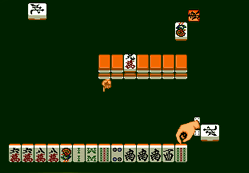 There really isn’t much to say about this one, other than the fact that mahjong fans would now be able to download the game and play it, as opposed to actually owning a cartridge. Of course, this would most likely have been left behind had the service come online in the U.S., but who knows? We did get Shanghai on the Master System. Like Putter Golf, playing online wouldn’t have been too much of a strain, but the drawn-out gameplay would have been murder on your phone bills. There’s not much to it, and if you’re a fan of mahjong games, then this would perhaps seem attractive. I guess it’s better than nothing and was probably quite popular in Japan, but personally I’d rather be playing Putter Golf or Sonic Eraser.
There really isn’t much to say about this one, other than the fact that mahjong fans would now be able to download the game and play it, as opposed to actually owning a cartridge. Of course, this would most likely have been left behind had the service come online in the U.S., but who knows? We did get Shanghai on the Master System. Like Putter Golf, playing online wouldn’t have been too much of a strain, but the drawn-out gameplay would have been murder on your phone bills. There’s not much to it, and if you’re a fan of mahjong games, then this would perhaps seem attractive. I guess it’s better than nothing and was probably quite popular in Japan, but personally I’d rather be playing Putter Golf or Sonic Eraser.
TEL-TEL Stadium
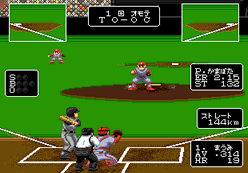 As one of the only two games released for the Mega Modem that actually permitted modem-to-modem play, TEL-TEL Stadium would have been an excellent choice for those few gamers looking for something to feed their new gadget (their only other option would have been TEL-TEL Mahjong). Bright, detailed graphics and solid gameplay fueled what would undoubtedly have been a really entertaining title, had it been given the proper environment in which to thrive. The only thing I can think of that would have deterred anyone from playing was the price of a long distance call. Playing with someone locally would have been cheaper, but then why not simply go over to their house and play?
As one of the only two games released for the Mega Modem that actually permitted modem-to-modem play, TEL-TEL Stadium would have been an excellent choice for those few gamers looking for something to feed their new gadget (their only other option would have been TEL-TEL Mahjong). Bright, detailed graphics and solid gameplay fueled what would undoubtedly have been a really entertaining title, had it been given the proper environment in which to thrive. The only thing I can think of that would have deterred anyone from playing was the price of a long distance call. Playing with someone locally would have been cheaper, but then why not simply go over to their house and play?
Sources
- Cifaldi, Frank. Spotlight: Baton TelePlay Modem. Lost Levels Online. October 2003.
- Kent, Steven L. The Ultimate History of Video Games. Three Rivers Press. 1st ed. 2001.
- Mailbox. Sega Visions Magazine. Oct./Nov. 1990.
- Matte, Jared. Sonic Eraser. Green Hill Zone. 2005.
- Modem Network Up & Running. Mega Play. Jan/Feb 1991.
- Sheff, David. Game Over: Press Start to Continue. New York: Random House. 1993.
- TurboGrafx-16 vs. Genesis. Electronic Gaming Monthly issue #8. Sendai Publishing. March 1990.

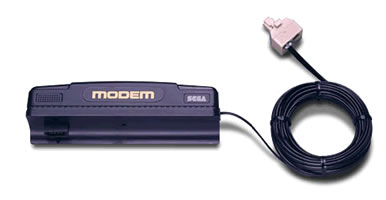
Pingback: L’époque où les consoles jetaient leurs premières lignes – L’Art de jouer
Pingback: Sega Genesis (Mega Drive) – Did You Know Gaming? Feat. Boku No Eruption |
Pingback: List: Console Save Types: Listing How Consoles Store Data | Black Falcon Games